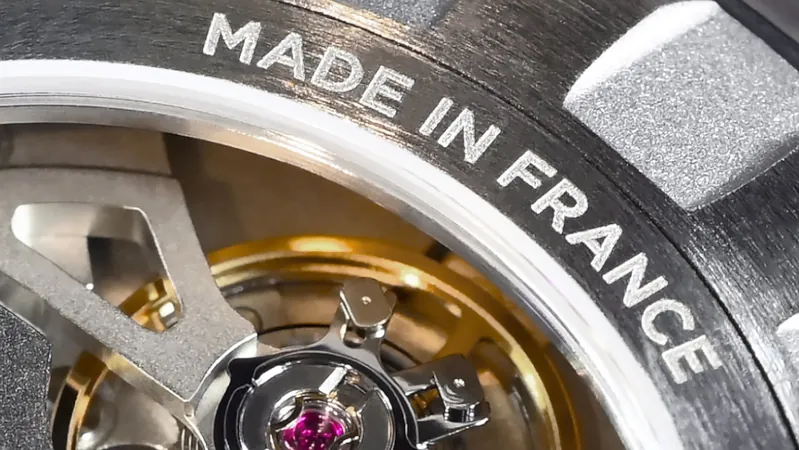
NASA’s Perseverance Rover is Pioneering Future Mars Spacesuit Technologies!
2025-03-31
Author: Nur
NASA’s Perseverance Rover is Pioneering Future Mars Spacesuit Technologies!
NASA continues to push the boundaries of space exploration with its Perseverance rover, which made headlines when it landed on Mars in February 2021. While the rover's main task is to study the planet's geology and search for signs of ancient life, it has a secondary, yet equally critical mission: preparing for future human exploration of Mars.
One of the essential steps in this preparation is the testing of various spacesuit materials. NASA has cleverly integrated samples of these materials onto the rover to observe how they endure the intense and hostile conditions present on the Martian surface.
The Importance of Material Testing
Currently, researchers at NASA’s Johnson Space Center are analyzing the performance of these materials after they've spent four grueling years exposed to Mars’ harsh atmosphere. The findings from this prolonged exposure are expected to significantly influence the design and functionality of future spacesuits needed for astronauts who may one day walk on Mars.
According to planetary scientist Marc Fries, “This is one of the forward-looking aspects of the rover’s mission – not just thinking about its current science but also what comes next. We’re preparing for people to eventually go and explore Mars.”
The materials under examination include five small samples—each measuring a mere 20 millimeters square, roughly the size of a postage stamp—mounted on a calibration target used by the SHERLOC (Scanning Habitable Environments with Raman & Luminescence for Organics & Chemicals) instrument installed on Perseverance. Among these are a polycarbonate helmet visor and two types of Teflon renowned for their dust resistance and nonstick characteristics, along with Vectran—an incredibly tough fiber utilized in astronaut gloves. The fifth sample, Ortho-Fabric, is a sophisticated construction featuring flame-resistant Nomex, breathable Gore-Tex, and durable Kevlar, often employed in bulletproof gear.
Facing the Martian Challenge
Mars serves as an extreme testing ground. Temperatures plunge far below freezing, fine dust erodes surfaces, and its soil harbors perchlorates, which are toxic to humans. The planet’s thin atmosphere offers scant protection from harmful radiation, including intense ultraviolet rays. This kind of exposure rapidly degrades materials, a fact highlighted by SHERLOC science team member Joby Razzell Hollis, who compared it to plastic lawn furniture fading and becoming brittle under the sun—a process that occurs even faster on Mars.
The initial results are intriguing. Roughly half of the evident changes in the suit samples occurred within the first 200 days following the rover's landing, with Vectran showing the earliest signs of wear.
Expert analyses are also examining how various suit components might degrade at differing rates, with the understanding that regions of a suit, like an astronaut’s shoulders, experience more direct sunlight than others.
Preparing for the Future of Space Exploration
Researchers at NASA are preparing a scientific paper detailing their early findings from SHERLOC’s analysis. Meanwhile, engineers at Johnson Space Center will conduct laboratory simulations that replicate the Martian environment—testing materials under conditions that mimic the carbon dioxide-rich atmosphere, pressure, and sunlight encountered on the planet.
These tests will assess how materials stretch, tear, or otherwise decay over time, comparing the results with real-time data collected by the rover. “The fabric materials are designed to be tough but flexible, so they protect astronauts but can move freely,” states Fries.
Understanding how these materials deteriorate is crucial because weakened fabrics could lead to fraying or tearing, potentially resulting in spacesuits that leak heat and air—issues that need to be solved before humans set foot on Mars.
The Broader Perspective
Beyond these vital material tests, the Perseverance rover is tasked with a broader scientific goal: collecting samples of Martian rock and soil. These samples may eventually be returned to Earth as part of NASA's Mars Sample Return Program, a collaboration between NASA and the European Space Agency.
This endeavor is strategically aligned with NASA’s ambitious Moon to Mars campaign, which includes upcoming Artemis missions aimed at returning humans to the Moon. Data gathered from Perseverance's mission—including insights on spacesuit durability—will pave the way for a safer human exploration of Mars in the years to come.
Ultimately, NASA is taking a monumental leap forward as it uses the Perseverance rover to not only explore Mars but also to build the technological foundations for tomorrow's explorers. The materials under testing today could very well become integral to the first human missions to the Red Planet.
Stay tuned for more groundbreaking updates from NASA and the world of space exploration!

 Brasil (PT)
Brasil (PT)
 Canada (EN)
Canada (EN)
 Chile (ES)
Chile (ES)
 Česko (CS)
Česko (CS)
 대한민국 (KO)
대한민국 (KO)
 España (ES)
España (ES)
 France (FR)
France (FR)
 Hong Kong (EN)
Hong Kong (EN)
 Italia (IT)
Italia (IT)
 日本 (JA)
日本 (JA)
 Magyarország (HU)
Magyarország (HU)
 Norge (NO)
Norge (NO)
 Polska (PL)
Polska (PL)
 Schweiz (DE)
Schweiz (DE)
 Singapore (EN)
Singapore (EN)
 Sverige (SV)
Sverige (SV)
 Suomi (FI)
Suomi (FI)
 Türkiye (TR)
Türkiye (TR)
 الإمارات العربية المتحدة (AR)
الإمارات العربية المتحدة (AR)